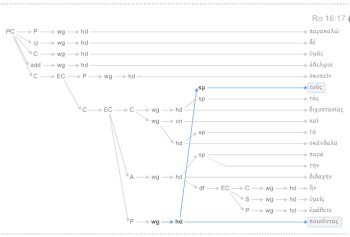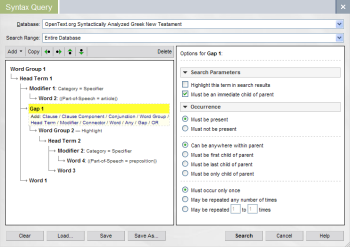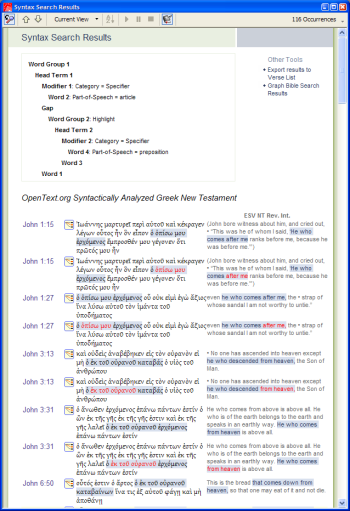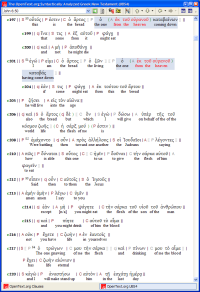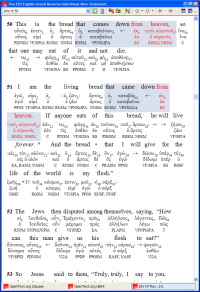In an earlier post, I wrote:
You’d be amazed the sorts of things you stumble upon in scrolling through the text and visually recognising similar graph structures in close proximity.
One of the things I keep an eye out for when scrolling through the Greek Syntax Graphs are gaps. If you’ve studied Greek, you’ll know that sometimes it seems like word order in Greek and word order in English have little if anything in common. So I keep an eye out for where one structure has an intervening structure. These sorts of things are called
The best example I can think of for Greek involves the definite article and the substantive it modifies. An easy example here again is John 1.1. In the below excerpt, the substantives (nouns in this case, ????? and ????) and their articles (? and ???) are emphasised:
?? ???? ?? ? ?????, ??? ? ????? ?? ???? ??? ????, ??? ???? ?? ? ?????.
In John 1.1, it is easy. The article directly precedes the noun, and the noun and article agree in case, number and gender. And this is usually the case. But not always. Sometimes there are
???????? ?? ????, ???????, ??????? ???? ??? ??????????? ??? ?? ???????? ???? ??? ??????? ?? ????? ??????? ?????????, ??? ????????? ??? ?????·
This is complicated for a few reasons; first because the substantive is a participle (a verb) and second because there are eleven words that separate the article from its substantive.
But this sort of thing jumps out at you when you scroll through the visualised syntax graph.
The good news is that you can now search for substantives with articles with a syntax search. But that’s not really what this post is about. When I looked at gapped examples of articular substantives, a lot of the time there were prepositional phrases in there. So, I wondered, how many times did the gap between the article and its substantive contain a prepositional phrase?
I constructed a query; it is shown below:
For the data that is currently available internally (John, Romans-Titus, Philemon, James-Revelation) I come up with 116 instances for the above query (though there are inadvertent duplicates meaning there are likely 58 hits … hey, we’re still in beta!). [Update:: 57 hits, it appears, with the duplicate problems addressed]
You can see some of the instances (including dupes) in the Syntax Search Results dialog below. The prepositional phrases are red; the extent of the matched structure has the shaded background.
Additionally, if I click on the reference in the left column, I’ll open up the underlying text, broken out by clause and clause component, with the same highlighting applied (graphic on left). If I click on the reference in the right (reverse interlinear) column, I’ll open the specified reverse interlinear with the same highlighting applied (graphic on right):
Don’t worry, the interlinear lines in
So, a few concepts to take home:
First, gaps happen. But with syntax annotation, you can take these sorts of things into account if you want to look for different syntactic structures in the text.
Second, interesting things might happen within the gaps, and you might want to search for things occuring in the context of gaps. And with syntax annotation, you can do that too.
Third, Syntax Search Results offer a few options for display of hits in context that are interesting. After all, context is pretty important. Showing a verse or two to supply some immediate context in the results dialog is useful, but making it easy to get to the full context of the result with the search hit highlighting preserved in a base text or a reverse interlinear brings you back to the text where your exegetical work can continue.

